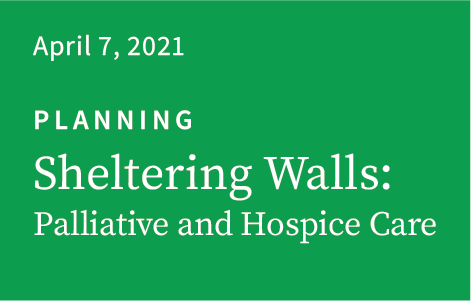Transcript
Sheltering Walls: Palliative and Hospice Care
The suggestion of palliative or hospice care for a loved one with dementia can be scary: It means their health has declined significantly. Although we know that change is a natural part of life, accepting it is a different story. Grief, anger, disbelief, and fear are just some of the emotions I’ve witnessed in patients, families, and friends. In the case of Alzheimer’s disease and other forms of dementia, the caregiver often has the added burden of having to make these decisions on their loved one’s behalf.
It might be hard to see it, but palliative or hospice care can be a source of comfort during a frightening time. A surprising fact is that people who are on hospice care live longer than those with similar types of illness who are not.
Why is that? I believe it is because of the care provided by hospice nurses and physicians 24/7. And I also believe it is because of the care that the entire team provides to the family by offering information about caregiver resources, documents such as advanced healthcare directives, and many other things—so that you do not have to figure out so much on your own.
As you witness the changes in your loved one and confront the decisions that need to be made in each phase of their decline, perhaps there will be comfort in the fact that you are providing this immensely challenging care in the expected final season of your loved one’s life. And you are not alone. And I believe that’s how we cope, together with the guidance of others—in this case, a team of professionals dedicated to bringing comfort during this unique time.
Hospice and palliative care have a long and rich history. Thanks to Dame Cicely Saunders, a nurse, physician, and social worker in Great Britain during World War II and the mother of hospice care, the phrase “total pain” entered our vocabulary. “Total pain” means that the pain of life-limiting illness is not just physical, but also has emotional, social, and spiritual dimensions. All of these are detrimental, and all require attention. Her second contribution was recognizing the need for a multidisciplinary team approach to address these diverse aspects of pain. Today, both hospice and palliative care offer patients and families a team that includes a physician, nurse, spiritual care provider, and social worker.
There’s often some confusion over what separates palliative care from hospice care. They’re similar in that they both address the care of people with serious, life-limiting disease. But there are important differences.
First, folks on palliative care have a more open-ended life expectancy than those on hospice.
Second, those on palliative care can receive both palliative treatment—that is, care to relieve symptoms and improve quality of life—and curative care. In contrast, those on hospice have a more limited life expectancy, and have moved from a treatment plan to a care plan that emphasizes comfort and quality of life.
Palliative care is also more accessible than hospice. The patient or family can ask for a referral to palliative care, or a physician can initiate the process. Palliative care services were initially found only in the hospital, but have started to appear in clinics to care for people who are not hospitalized. The team members also make house calls.
Hospice care can also be requested at any time but can only be initiated after a physician certifies the patient’s eligibility. A hospice referral happens when curative care options have been exhausted, and it’s time to focus on the best quality of life where the patient lives—whether that is their family home or a care community.
Let me speak a bit about my particular role as a spiritual care provider. I use “spiritual” in a broad sense, focusing on more universal concerns that address the question, is there a way to find meaning in what is happening through the spiritual or values-based aspect of their lives? What drains the family emotionally, and what sustains them? What are their fears or concerns?
My goal is to meet my clients–whether patient or caregiver—where they are so that I can provide compassionate care consistent with their values. For some, my work is deep, attentive listening. For others I might offer sacred scriptures, poetry, or music. Some people feel more sustained by factual information and resources.
My approach to people with Alzheimer’s disease is very specific. I take it slow. I move slowly, speak slowly, and allow silence. These intentional actions give the patient a sense of me as a non-threatening participant in their world.
I then evaluate the responsiveness of their sensory faculties—vision, hearing, smell, touch—and use them to guide my interventions. I carefully observe what folks are interested in. I will show photos of nature scenes and see if they look at them. I will sing a bit and see if they seem interested. If there is a flower in the room, I will bring it over to see if they respond to the fragrance. I will squeeze a shoulder or take a hand and see if they appear comfortable with touch.
This evaluation is ongoing. I’ve noticed that responses change and may require a different intervention over time. At the same time, I take into account that the patient is less likely to respond as their disease progresses, though I always assume they are still taking things in, which guides how I speak to them. So, unless unwelcome, I persist with the interventions they accepted earlier, such as music, prayers, poetry, and gentle touch.
With verbally responsive folks, I select topics of interest to them. I compliment their shirt or hair or talk about something concrete in our immediate view—a photo or memorabilia or the colors in their room. It doesn’t matter if they don’t reply. I orient them to the season and the weather, recent holiday celebrations.
I often sit beside my clients and settle into the peace of our shared space. If the space isn’t peaceful, I join them in walking, or push them in their wheelchair, or try to understand and name their frustration.
Music can create a calming space. For patients with a faith tradition, I play music from that tradition. I play secular music from their youth. As an alternative to speaking, which can feel demanding, I often sing. I also find repetitive sounds and rhythms helpful in reaching my clients or creating a peaceful atmosphere. I may turn to chants, such as the Taizé chant “Dona Nobis Pacem,” which means “Grant Us Peace.” For non-verbal folks, I even go back to nursery rhymes.
My main goal is to simply be with the person I’m visiting—to enter their world and let their abilities guide my actions. I don’t want to challenge them to do or remember things they cannot do or remember. I aim to find what they can do and what they enjoy, and provide these things as much as possible.
If you hear the recommendation for palliative care or hospice, I hope you won’t feel afraid. You may feel brokenhearted. You may feel numb. You may feel shocked, sad, or even a little relieved. All of these feelings are part of this journey. But I hope your fear is quelled by the care offered by the professionals on your team. These words by John O’Donohue speak to the protective space created by palliative and hospice care:
“On our farm in the winter, we put the cattle out on the mountains into the winterage. … Because the landscape is bleak, there is little shelter. Every so often out there, one notices semicircular walls. The cattle know them well. These are the ‘sheltering walls’ when winds and storms blow up.”
May we be a sheltering wall for you at this time.
Jennifer Fargo Lathrop
Spiritual Care Provider
Palo Alto Medical Foundation

